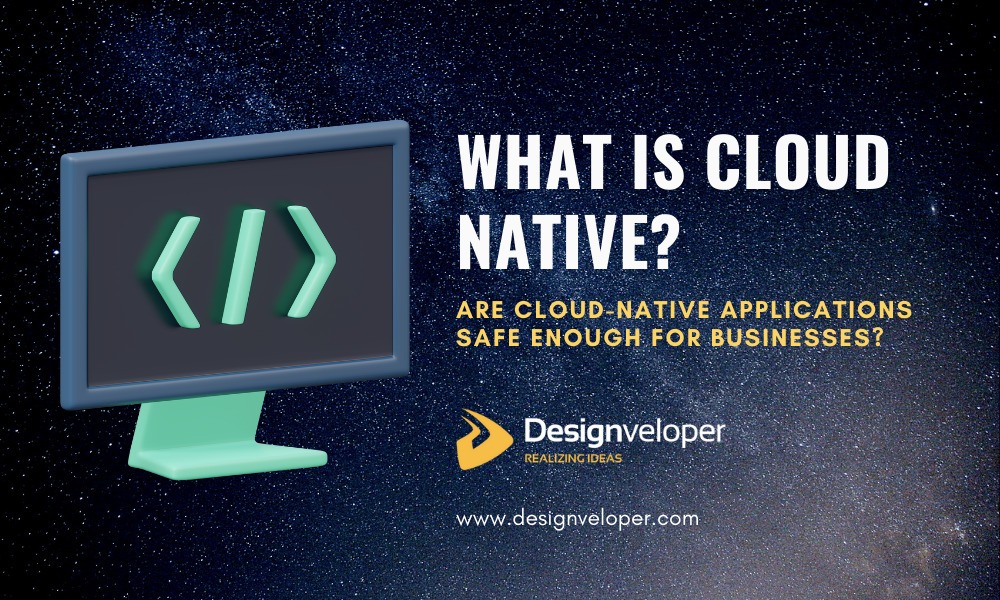The digital landscape is a fast-changing one. Advancements come every other day, and some make things secure while others create new vulnerabilities. If we look at recent app development trends, it can be seen that cloud-native is increasingly becoming the industry’s norm. Many of the leading application development companies are shifting to cloud-native, which leaves us with one critical question: Is cloud-native secure? Especially for businesses?
To answer that, we need to build an understanding of what cloud-native is, what are the security threats faced by Cloud Native, and how they can be mitigated. Only then can we reasonably evaluate the security of Cloud Native for business applications?
What Exactly is Cloud-Native?

Cloud-native applications, as the name suggests, are hosted on the cloud. The term ‘cloud native’ refers to a set of design principles, software, and services focused on building software architecture with the cloud as the primary hosting platform.
The objective of adopting the cloud-native approach is to make more resilient, scalable, and secure applications.
On paper, cloud-native is one of the most secure approaches to application development and deployment. However, it is not without its own security problems too. The OWASP Top 10 2021, for example, still influences the cloud-native infrastructure.
Security Concerns Surrounding Cloud-Native
1. Limited Visibility
The first security drawback of cloud-native is that, unlike on-premise deployment. You cannot be sure about the security aspects of the cloud environment the application is hosted on. Hence, it becomes the duty of the IT team of a business to keep track of every single resource added to the application. This monitoring has to continue from the moment a new resource is created to when it is no longer used.

2. A Wide Variety of Threats
Because the cloud is open to anyone with an internet connection, people start coming up with newer ways to undermine the system’s security. As the hackers and attackers continue to advance their methods, developers and cybersecurity experts also need to improve their defending methods against such attacks.

The cloud attracts all kinds of attacks, from brute-forcing to phishing and from stolen credentials to SQL injection.
It’s not all bleak, however. If businesses know the concepts of data analysis, threat detection, and intrusion detection, they can avoid such attacks. It is not that the cloud is not safe. The fact of the matter is that the users need to be cautious to use cloud-native apps for business safely.
FURTHER READING: |
1. What Are Cloud eCommerce Solutions? |
2. 4 Types of Cloud Computing: Understanding the Difference |
3. What Are the Pros and Cons of Cloud Computing? |
3. Centralizing Security Policies is Difficult

As we know it today, the cloud-native environment includes a large number of tools from a variety of different providers and developers. That accordingly makes implementing consistent security policies extremely difficult.
According to the Enterprise Strategy Group, “In addition to increasing cost and complexity, the use of environment-specific cybersecurity controls contributes to an inability to implement centralized policies.”
Using a variety of different security tools is the best solution to this problem we have right now. For businesses looking to migrate to cloud-native, it is imperative to have a security solution that can streamline the entire cloud infrastructure. All infrastructure components must be also unified, and rulesets, policies, alerts, and remediation tactics are automated.
Recommended reading: Navigating the Cloud: How Web Hosting Drives Efficiency in Corporate Travel Platforms
4. Misconfigurations
Another issue facing cloud-native security is that of not properly configuring cloud-related systems. It is one of the most prevalent cloud-native security threats. It was the highest cloud security threat according to a recent report. In particular, 68% of the companies cited that misconfiguration was their greatest concern regarding cloud-native security.
When using cloud-native, the only way for a business to avoid this is to properly configure all components of the cloud environment to make sure no vulnerability can be exploited to undermine the security of the environment.
5. Slow Security Processes
One of the main reasons enterprises are moving to the cloud is because of the speed, agility, and flexibility it offers. As necessary, security can still fall behind the incredible speed of the continuous integration and deployment (CI/CD) pipeline of cloud environments.
The problem is not that companies do not implement security measures. Many of the organizations using the cloud fail to give security more consideration than efficiency and speed.
But they can fix this issue by shifting security as far left as possible and ensuring security is always the first priority in the development, integration, and deployment process.
Tackling Cloud-Native Security Threats – The Solution

It is evident that there are several cloud-native security issues, but there are solutions to these problems available in the market. Cloud Security Posture Management (CSPM) tools can help automate the management of security across the diversified infrastructure of cloud-native. These include logging as a service (LaaS), Software as a Service (SaaS), and Platform as a Service (PaaS) solutions.
CSPM tools and solutions can make it possible for businesses to identify and timely mitigate potential risks through security assessments and automated compliance monitoring. Companies can also use CSPM tools to automate the governance of security aspects across different cloud-based components.
Conclusion – Is Cloud-Native Safe Enough?
It is evident without a doubt that cloud-native is a solution that provides a lot of benefits to businesses, but security gaps do remain a massive concern. These security gaps mainly result from disparate security solutions, and a lack of visibility can further compromise security. The cloud is extremely scalable, and the deployment velocity is incredibly high, further making it difficult to implement proper security measures.
Is cloud-native safe? Yes, it can be if harmonious security measures are implemented as scalable and fast as cloud-native. In the end, if security is shifted left far enough and no known vulnerability is left, cloud-native is completely safe, but any slack in the security implementation can spell disaster.





















